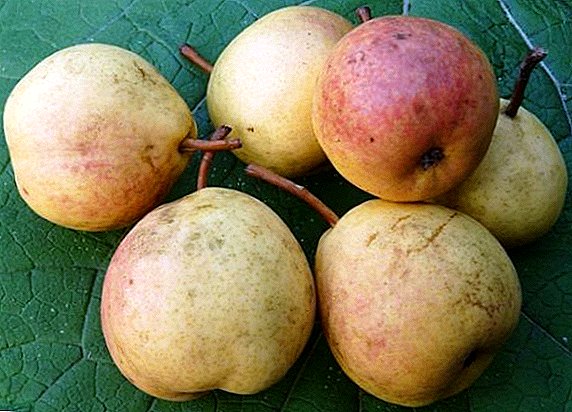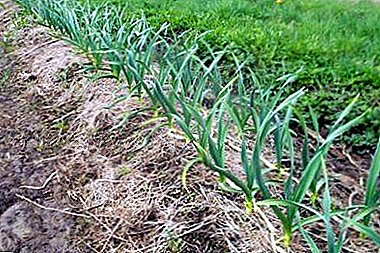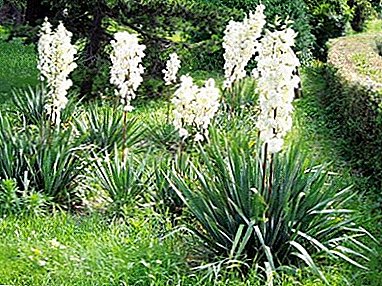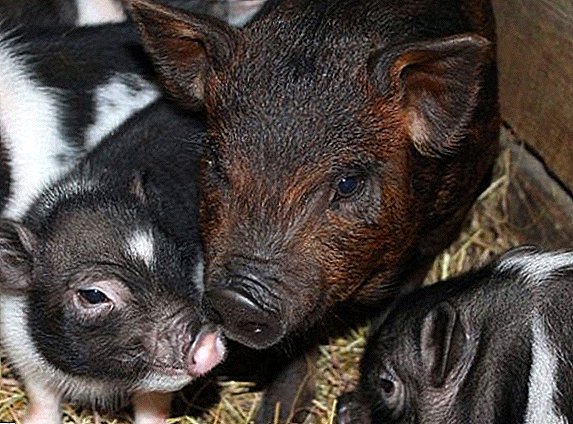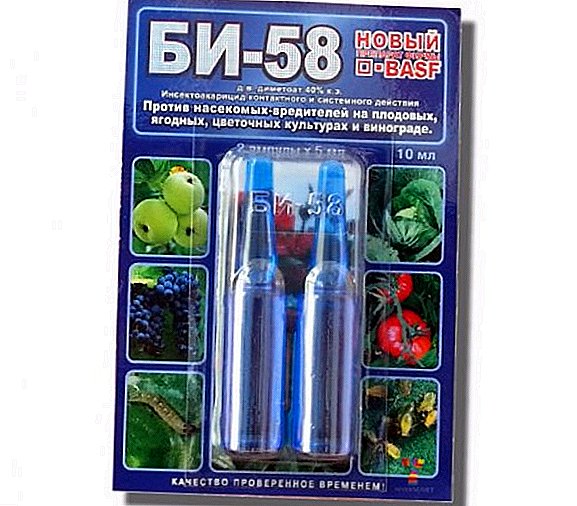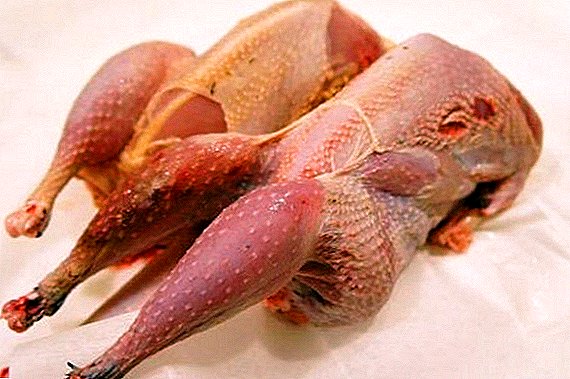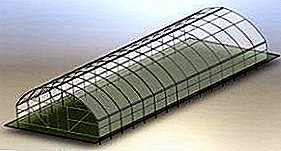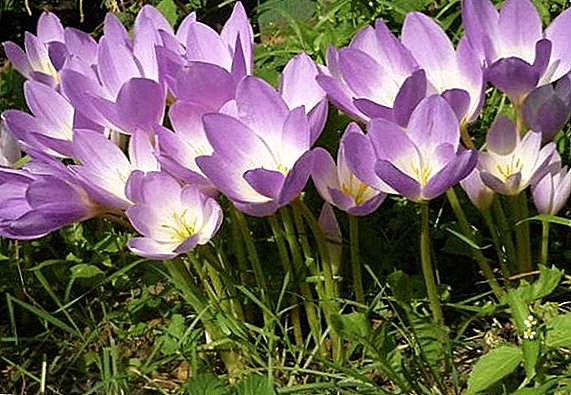 Nature never ceases to amaze us: one of these miracles is the autumn crocus, which is characterized by an unusual sequence of development. In the spring leaves grow with seed bolls that ripen to the beginning of summer, and the plant falls asleep. But the decoration of any flower - buds, bloom in the fall. How to grow colchicum and care for him, we will tell further.
Nature never ceases to amaze us: one of these miracles is the autumn crocus, which is characterized by an unusual sequence of development. In the spring leaves grow with seed bolls that ripen to the beginning of summer, and the plant falls asleep. But the decoration of any flower - buds, bloom in the fall. How to grow colchicum and care for him, we will tell further.
Description
Colchicum (colchicum) is a perennial bulbous plant of the Seasonal family. Under natural conditions, it grows in meadows and forest glades in south-eastern Europe, the western territory of Asia and Africa.
Did you know? Plants that tune their life cycle under natural phenomena are called "ephemeroids."In the genus Perennial, there are about 160 species, but only some are grown in gardens:
- autumn (Colchicum autumnale);
- great (Colchicum speciosum);
- Agrippa, or motley (Colchicum agrippinum, tessellatum);
- Byzantine (Colchicum byzantinum).




The life cycle of autumn crocus deserves special attention. An adult, mature plant leaves a tuber bud to the beginning of autumn. Moreover, the flower appears above the surface of the soil on a bare stem and after fading, it withers and turns yellow on the ground. The height of the flower during flowering is 15-20 cm.
Familiarize yourself with the perennial cultivation of autumn crocus in the open field and the main types of colchicum.
Depending on the variety of colchicum from one bulb, different numbers of flowers may appear, which are regular and double. The color of the inflorescences also depends on the variety: white, purple, pink, purple, striped and chess. On rainy days, the flowers close and take the form of beautiful glasses. The plant blooms for 15-20 days, and this period depends on what the weather is worth.
Important! A hot autumn crocus flourishes faster.Frost flower is not terrible: with their onset, he only falls to the ground.
The next stage of life begins in April-May, when juicy, bright green broad leaves grow from a bulb, growing to 30-40 cm.  Autumn crocus under the snow. And if in the fall the flower was fertilized, a seed box would be noticeable between the leaves, which, unknowingly, many consider to be a bud. Seeds are formed from the ovary of a flower, which is located in the soil. Sunflower seeds ripen in late June - mid July and crumble on the ground. In this case, the box becomes brown, and the leaves turn yellow and wither.
Autumn crocus under the snow. And if in the fall the flower was fertilized, a seed box would be noticeable between the leaves, which, unknowingly, many consider to be a bud. Seeds are formed from the ovary of a flower, which is located in the soil. Sunflower seeds ripen in late June - mid July and crumble on the ground. In this case, the box becomes brown, and the leaves turn yellow and wither.
Breeding methods
There are three known breeding species of autumn crocus: bulb division, daughter tubers and seed. Consider each of them:
- Seed (generative). This method will take a lot of time, since the colchicums planted in this way only bloom after 6-7 years, when the tuber grows and gains strength. Moreover, this method is not suitable for many varieties.
- A tuber of colchicum forms several shoots during growth. In summer, when the plant is at rest, the bulb can be dug out and divided into several parts so that each contains its own shoot. Slices are rolled in charcoal and dried. After 3-6 days they can be planted. The depth of the hole is 12-18 cm.
- Daughter bulbs are the easiest way to grow crocus. Thus planted Kolkhikum blooms in 1-1.5 months. The process begins with the collection of bulbs. Young tubers, which by the middle of summer already have time to appear, are harvested when the seeds have ripened and the foliage has laid down on the ground. The bulbs are carefully dug, cleaned and the remnants of the leaves and old tubers removed. Scales that envelop the onion should not be removed. Next, the material is washed and pickled with a weakly concentrated solution of potassium permanganate. After this preparation, the tubers are dried and stored until planting in a shaded place at room temperature (+ 22-24 ° C).
 Autumn crocus seeds are in a box between the leaves
Autumn crocus seeds are in a box between the leaves
Did you know? Experimentally (in rabbits and mice), the abortive properties of the colchicum have been proven.
Growing up
Colchicum is perfectly adapted to the climatic conditions of the middle zone of the Russian Federation. Plant it better in well-lit areas. Allowed to plant a plant in light partial shade.
Bulbs are planted in the unprotected soil at the end of August - beginning of September, although these periods are adjusted depending on the climatic specificity of the area. However, experts believe that the best period for planting an autumn crocus is August. 
Important! Landing time is calculated in such a way that no less than ten days pass from the day of planting to frosts.Kolkhikumy grow on almost all soils, but preferably those that have an acidity of pH 5-8. Outside of these indicators, the plant will feel uncomfortable.
The composition of the soil can be different, including loam. But it is better to lay a sufficient amount of organic matter (superphosphate, ash, phosphate, ash, humus), because in the fertile and loose soil the autumn crocus creates luxurious hats of flowers and forms a large number of tubers.
Learn more about growing the most popular bulb flowers: tulip, gladiolus, snowdrop, narcissus, babian, lily.
When planting bulbs, the depth of the hole is determined by the size of the planting material. Small corms are planted 6-8 cm deep, at a distance of 10-15 cm from each other. Large material needs deep holes - 12-15 cm, and the distance between them should be 20-25 cm. It is necessary to plant the bulbs so that their tops remain above the ground.
Planting in the seed way looks like this: freshly harvested seeds are sown in the beginning of summer in fertile, loose and moist soil to a depth of 1-2 cm.  Pre-seed material is soaked briefly in water. If the seeds were not planted immediately after harvesting, they will have to be stratified for six months before planting, placing them in a refrigerator.
Pre-seed material is soaked briefly in water. If the seeds were not planted immediately after harvesting, they will have to be stratified for six months before planting, placing them in a refrigerator.
Important! Instead of soaking, gardeners are advised to pour seed into a nylon stocking or a sock and lower the toilet bowl into the tank. At each discharge, the water will wash the seeds, removing the inhibitors, which increases germination.Before planting in the wells organize the drainage layer and sprinkle it with sand. Shoots will appear next spring, but sometimes more time passes.
For seedlings need some care. They are thinned, watered if necessary, until the foliage wilts, weed, and harbor for the winter.
Care
It is easy to take care of the crocus forever, and the whole complex of measures is minimized, however, the basic procedures for successful cultivation are:
- Watering. It is required only once a week during flowering and only in case of hot weather. Excess water is harmful to the plant. To get rid of moisture stagnation during the thaw, around the tuber make grooves, which will leave the water, and clean the soil from the snow.
- Fertilizer. A mandatory condition only during planting, the rest of the time it takes infrequently (simple varieties feel fine without dressings): in spring and autumn. For intensive growth in the spring, you can use nitroammofosku (40-50 grams per square meter). In the fall they are fertilized with compost.
- Weeding, removal of withered buds and dried leaves. This procedure prolongs the decorativeness of the flower.
- Preparing for the winter. It is especially important to harbor low-resistant varieties. In the winter they are covered with dry leaves, rotted manure, garden compost (the optimal layer is 10-15 cm) or nonwoven fabric.
- Seating. The flower must be regularly and timely thinned (planted). Otherwise, with a large accumulation of tubers, the autumn crocus will enter the vegetative phase and stop blooming. Seating is carried out once every 2-3 years after the final withering away of the foliage (midsummer - early September). The autumn crocus tubers are dug, cleaned, dried and planted in a new place. If the soil has not changed, it should be enriched with humus (compost), mixed with a small amount of sand. The depth of the hole should be three times the diameter of the bulb, and the desired distance between the flowers - 15-20 cm.
- Do not prune Kolkhikum leaves. - they must independently turn yellow and dry.


Important! All pieces of autumn crocus are poisonous, so the work must be done with gloves.
Diseases and pests
Snails and slugs, for which the juicy leaves of a flower are a real delicacy, are the biggest nuisance when growing ever-autumn crocus. The most effective and environmentally friendly way to get rid of them is to collect them manually: insecticides have virtually no effect on soft-bodied pests. Experienced gardeners create mechanical obstacles for gastropod pests by scattering ashes, fine gravel, shell rock or eggshell around.
Did you know? The ancient Greeks were convinced that the autumn crocus arose from the drops of Prometheus blood. In Russia, this plant was called an autumn tree, a dog bow or winter road, and the British called it "naked lady."In case of repeated flooding of the soil, the autumn crocus may be affected by gray mold. With minor signs of disease, watering is reduced, and the plant is simply treated with a fungicide (Champion, Topaz, Kuproksat, etc.). From heavily infected plants have to get rid of.
As we see, the cultivation of a colchicum still requires a certain experience, time and endurance: try your hand at using this information. We hope you will succeed, and on your site you will be able to create unusual autumn flower beds.
Learn how to use colchicum in traditional medicine.
VIDEO: LANDING AND CARE OF A TIMELESS IN AN OPEN GROUND
Reviews




